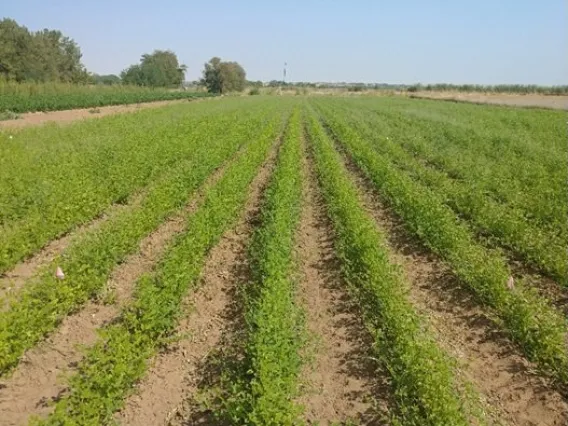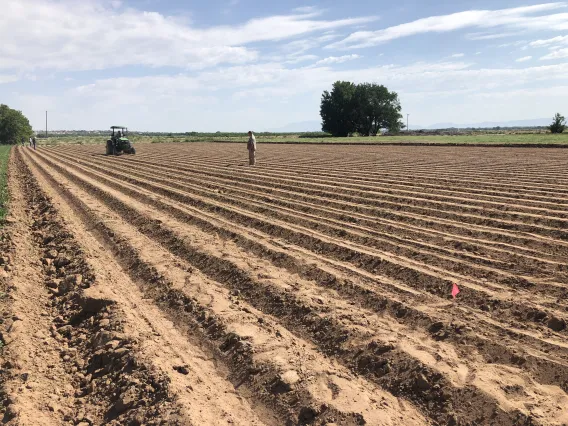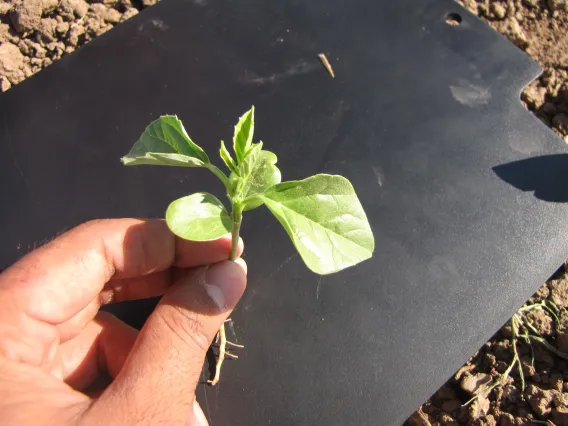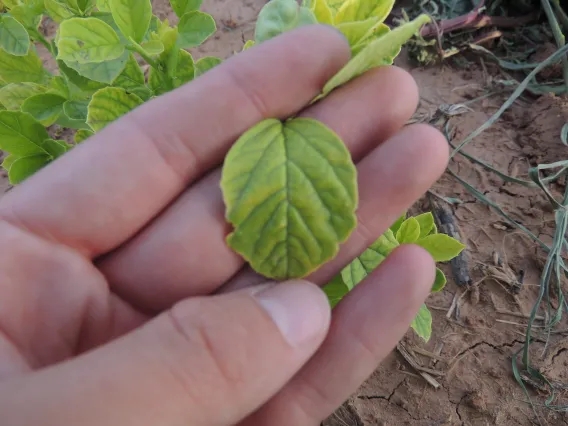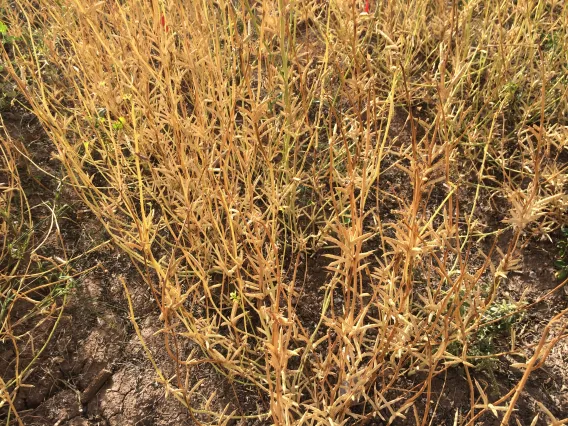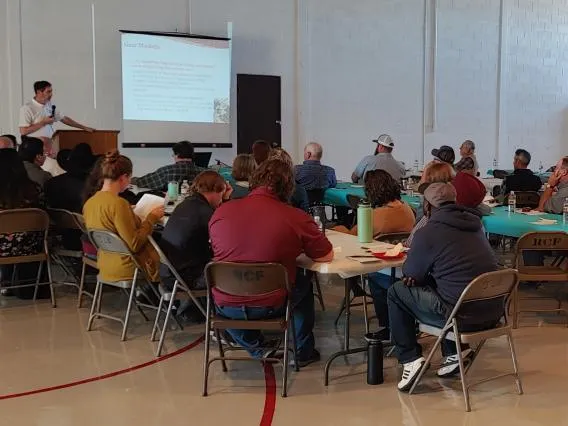Guar Basics
Guar (Cyamopsis tetragonoloba), also called cluster bean, is a summer legume that is drought-tolerant with a low water use requirement. Guar is very well adapted to arid and semiarid climates, characterized by high temperature and plenty of sunshine. Guar is a viable rotation crop for growers in New Mexico and can help to diversify the crop production systems.
Although guar can be used for human and animal consumption, the greatest utility of guar is for its gum (a white powder) which can be extracted from the beans. Guar gum has many industrial applications that make it a very valuable commodity. The guar gum contains galactomannan, which is a polysaccharide used as a thickener and stabilizer in food industries, in pharmaceutical industries and for cosmetic products. However, more than 90% of guar gum is utilized in the oil and gas industry, where it is used as a gelling agent added to water, thus creating a high viscosity fluid that fractures the subsurface shale layers more efficiently for the liberation of oil and natural gas.
Most of the guar gum used in the oil and gas industry in the United States is currently imported from Asia, but it is possible to grow guar in the Southwest successfully and efficiently, to support domestic production of guar gum. The Sustainable Bioeconomy for Arid Regions Center in Arizona through the funding from USDA/NIFA is currently funding several projects in New Mexico, to optimize the growth and yield of guar. On-going trials are focused on variety evaluation, optimal seeding rates, irrigation and fertility management.
Land Preparation and Planting Guar
Appropriate land preparation practices are essential for successful germination and emergence of a guar crop. Guar is a very tender plant especially during the early growth stages. It is important to undertake primary and secondary soil tillage preparations to create a friable and smooth seedbed for guar to germinate and emerge. After establishment, guar becomes resilient and can withstand environmental stressors.
Primary land preparation includes plowing the soil and subsoiling to break up the hard pan, thus enabling guar plants to penetrate deeply into the soil profile. Guar is a tap-rooted crop, capable of growing deeply into the profile to extract nutrients and water. The presence of a subsurface pan can hinder the extent to which guar roots can explore the soil for nutrients and water, thus limiting the resiliency of guar when exposed to drought. A regular moldboard plow and subsoiler can be used for primary land preparation before planting guar.
Secondary soil tillage is also necessary to break the large clods and provide a smooth seedbed for guar establishment. Soil disking equipment and harrows can be used for the secondary tillage operations to ensure a finished seedbed before planting guar. In southwestern New Mexico, it is customary to grow legumes (beans) on raised beds. In soils that have some drainage issues, it is better to grow guar on raised beds to avoid opportunistic root pathogens that tend to operate in poorly drained soils. Raised beds encourage the soil to drain better and protect guar roots from receiving too much moisture. Guar can be grown in a wide variety of soils but thrives best in a well-drained soil with coarse to medium texture. Due to susceptibility of guar to waterlogging, heavy clay soils are not recommended.
Several conventional planters an be adapted to grow guar. It may be necessary to purchase a seed plate that is appropriate for guar’s seed size in order to achieve uniform and appropriate seeding density in the field. Depending on seed viability and variety, a seeding rate of 8-12 lbs/ac is recommended for proper establishment. Either 30-in or 40-in rows can be successfully used to grow guar, as research has shown that both planting widths produce similar yields. This means that you do not need to change the width of your farm equipment to grow guar.
Land preparation and planting of guar do not necessitate that you invest in buying new equipment. The equipment already present on your farm can be adapted for guar production.
Planting Dates for Guar
Identifying the optimal planting date for a guar crop is a key factor for crop establishment and achieving optimum yields. Guar is a crop that needs warmer soil temperatures to germinate. As most crops in the region are planted on raised beds, growers in New Mexico can plant guar on raised beds and use the same equipment that they generally use for crops such as cotton, chile peppers, and onions. The beds are often spaced at 40-inches.
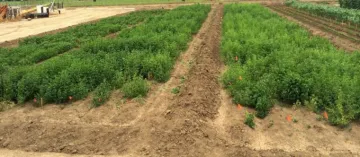
Guar seeds planted at three different times in Las Cruces, New Mexico. (Far left rows planted June 16th, middle rows planted May 15th, far right rows planted April 25th; photo taken in August.)
Guar plants are able to achieve optimum growth and development when planted around mid-June in New Mexico. Planting too early can lead to guar seeds sitting in the ground without having a chance to experience the warm soil temperatures needed to germinate. This extends the growing season, without improving crop growth and/or productivity. Research conducted in New Mexico showed that when guar was planted in mid-April or mid-May, there was no advantage in terms of seed yield than when the crop was planted in mid-June.
Generally by June, the ambient soil and air temperatures are quite warm, which leads to faster germination and emergence of guar seedlings. Germination by mid-June also allows for the plants to accumulate the required number of growing degree days (GDD) to fully develop and produce pods. This also coincides with early vegetative growth and the typical timing of precipitation in the region. Hence, providing moisture needed for optimum growth while relying less on irrigation.
If planted later in the season after the end of June, guar plants show reduced growth and development as they are not able to achieve the required number of GDD to complete various growth stages. For instance, later planting of guar in mid-July showed shorter plant heights, reduced biomass and ultimately reduced seed yields as compared to those planted in mid-June.
Growth Stages
(Click on images to see Growing Degree Days.)
Guar Cultural Practices
Guar is a legume that grows and thrives in arid and semiarid regions. However, for optimal yields, attention must be paid to cultural practices that will enhance the growth and development of guar. Specific cultural practices important for guar production in the field include seed inoculation, fertilization, weed, pest, and disease control.
Seed Inoculation
As a legume, guar is able to perform biological nitrogen fixation in association with soil bacteria like Rhizobium species. Rhizobium bacteria live in the soil and when guar begins to grow, these bacteria colonize the roots and live inside several roundish nodules attached to the plant roots. Rhizobium bacteria survive inside these nodules by receiving simple carbohydrates from the plant and in return, the bacteria convert the nitrogen gas in the soil to a form of nitrogen that plants can absorb and use. That is why legume crops require little to no nitrogen fertilizer to grow and produce adequate yields.
Guar can form good nodules if the necessary guar-specific Rhizobium bacteria are present in the soil. If the necessary Rhizobium is absent, guar will not produce nodules, and this can lead to lower crop yields if no extra nitrogen fertilizer is added. In some soils, guar-specific Rhizobium bacteria may be in abundance and in such soils, guar will form nodules and fix nitrogen very well.
Some soils may have no guar-specific Rhizobium bacteria present, and in such cases, guar seeds may need to be treated before planting by using commercially available inoculants. The inoculants mostly come in a powder form, which is used to coat the seeds in a container before transferring them into the seed hopper for planting. You need to read the product label of any inoculant and apply as recommended on the label to get the best results. It is recommended that guar farmers inoculate their seeds before planting to ensure nodulation, unless they are sure that the soil has a track record of nodule formation with guar.
Fertilization
Like other crops, guar needs adequate amounts of soil nutrients to produce economic yields. There are typically 17 nutrient elements that plants generally need to grow, some of which are essential for guar. It is recommended that guar farmers complete a chemical analysis on their soil close to planting, to evaluate the nutrient status of their fields and add any deficient nutrients as prescribed by the soil testing laboratory.
Guar requires nitrogen for crop growth and yield, however, since guar is capable of biological nitrogen fixation, extra nitrogen fertilizer may not be necessary in fields where nodulation is effective. In many fields of the arid Southwest however, guar nodulation does not occur. In these cases, a nitrogen fertilizer application is required for good yields and the nitrogen should be applied based on the soil test results.
Phosphorus is another nutrient element that can be limiting for guar growth. Legumes generally need sufficient quantities of phosphorus for efficient biological nitrogen fixation and good root growth Phosphorus deficiency will severely limit the growth and yield of guar, so it is advisable to apply phosphorus based on the soil test results.
Other nutrients in arid and semiarid regions that can limit guar growth include iron and zinc, which tend to be deficient in soil with high pH. To assess if these elements are low in your field, a soil sample is necessary and should be processed at a soil testing laboratory. The soil testing laboratory will provide recommendations on the amount of nutrients to add to the soil to prevent deficiency. Because iron and zinc are required in very small amounts, it is often possible to correct their deficiencies using a foliar spray on the leaves of the guar crop. Contact your local Extension Agent or crop consultant to help with choosing appropriate products for application.
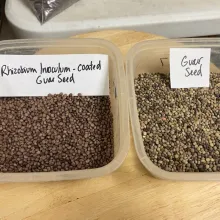
Untreated guar seeds (right) and inoculated guar seeds (left)
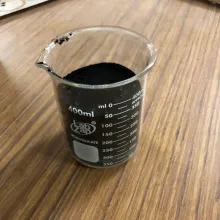
Guar inoculum inside a beaker
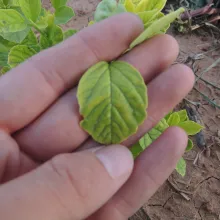
Iron deficiency symptoms on guar leaves
Weed Control
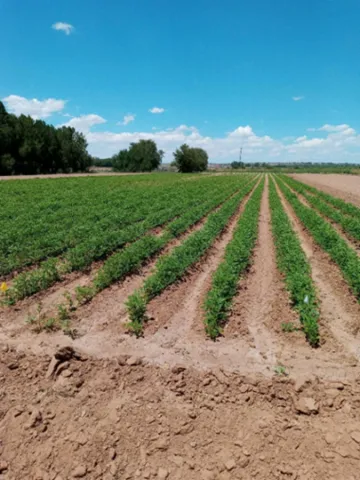
Recently cultivated guar field
Guar growth and yield is very sensitive to weeds. It is often recommended that guar should not be grown in a weed-infested ground, unless effective weed control has been performed before planting. Weeds generally compete with crops for sunshine, nutrients, and water, and the higher your field’s weed population, the more your crops may be lacking in important resources needed for good growth and yield.
Guar crops grow relatively slowly at the beginning of the growth cycle, and effective weed control is necessary at this stage to prevent yield losses. Preplant herbicide application is recommended, with successfully used preplant herbicides in the arid and semiarid Southwest including trifluralin (Treflan 4EC) and pendimethalin (Prowl H2O). Postemergence herbicide options are limited in guar, but herbicides such as clethodim (Intensity) can be used to control grasses in guar fields. Read the labels of these herbicides to know the timing, rates and methods of application for best results. It is also possible to undertake mechanical cultivations in guar fields during the growing season.
Pest Control
Pest or insect pressure is typically very low on guar grown in arid and semiarid regions. Guar midge is the most important insect pest of guar in the Southwest. Guar midge deposit their eggs in guar buds during the growing season. The main damage occurs during the larval stage of this insect, which develops in guar buds and causes the buds to fall off after the insects complete their development. When many buds become affected, seed production will be significantly reduced and a high level of infestation can cause significant yield losses of up to 30%. This insect tends to be more prevalent in guar grown in sandy soils. Sprinkler irrigation or rainfall have been shown to reduce the presence of guar midge significantly. Appropriate insecticides may also be used to control this insect pest. Farmers need to scout their field for guar midge to be able to identify the problem and use appropriate control measures.
Other occasional pests found on guar include:
- Alfalfa Hoppers
- Pea Aphids
- White Grubs
- Thrips
- Whiteflies
Contact your local Cooperative Extension office if you need information on pest identification and control.
Disease Control
Diseases are very low on guar grown in arid and semiarid regions. Some of the diseases that have been recognized on guar include:
- Alternaria leaf spot – This is a disease associated with high humidity and can occur under sprinkler irrigation or during periods of high rainfall. This fungal disease creates brown lesions on the leaf between the bloom and pod forming stages. This disease can lead to the eventual death and dropping of the affected leaves.
- Southern Blight – This is a fungal disease that causes the entire plant to wilt and die. This disease can be managed by practicing good crop rotation, deep burial of residue, and planting on raised beds.
- Bacterial Blight – This is a seed-borne disease that can affect guar at different growth stages from seedling to maturity. This disease manifests itself on the plant leaves as large angular lesions leading to defoliation. The best way to control for this disease is to use certified seeds.
Contact your local Cooperative Extension office if you need information on plant disease identification and control.
Guar Harvesting Strategies
Harvest Aids
Efficient harvesting of guar is important for achieving optimum seed yields. Guar is an indeterminate crop, where all guar plants do not mature uniformly in the field. To minimize seed yield losses due to uneven maturity or to synchronize maturity and avoid any new growth from taking place while plants mature, different types of chemicals, called harvest aids, may be used to defoliate leaves and facilitate mechanical harvest.
There are harvest aids that are labelled for use in guar: Paraquat (30.1%) and Sodium Chlorate (52%). Preliminary results from research done at Texas AgriLife (Trostle, 2013) showed the effectiveness of these two chemicals in guar. Chemicals should be applied on a sunny, hot, and humid day. Avoid spraying when there is a strong wind blowing to avoid any drift to other fields. More specific information about the labels of these chemicals can be found at: Chemical Management Data Systems.
Although an added expense for production, using harvest aids can help terminate the growth in the crop which allows for an earlier harvest of seeds for optimum yields.
Harvest Timing when Harvest Aids are Not Used
Delaying harvest beyond full maturity can significantly affect seed yield due to losses from adverse weather events or bird predation. It is time to harvest when 75% or more of the pods turn brown and are relatively dry. If harvested too early, a relatively sizeable portion of the pods may have not yet matured and dried, and will therefore be lost during harvest. On the other hand, if harvested too late, shattering losses due to inclement weather later in the fall/winter or even bird or rodent predation may lead to losses in yields.
Generally, when planted around mid-June, guar takes 120-135 days after planting to mature and be ready for harvest around early November.
Harvest Equipment
Guar can be harvested with grain combines with minor adjustments. Because guar plants have pods much closer to the ground as compared to other grains, it is important to adjust the heights of the combine reels to be able to capture most of the pods during the harvesting and to minimize seed losses.
New Mexico Alternative Crops Conference
The Alternative Crop Conference featured information on cultural practices for successfully growing guar and guar production economics. Guar processors from Guar Resources presented on guar contracting processes. SBAR students presented their posters on various SBAR topics with the audience.


